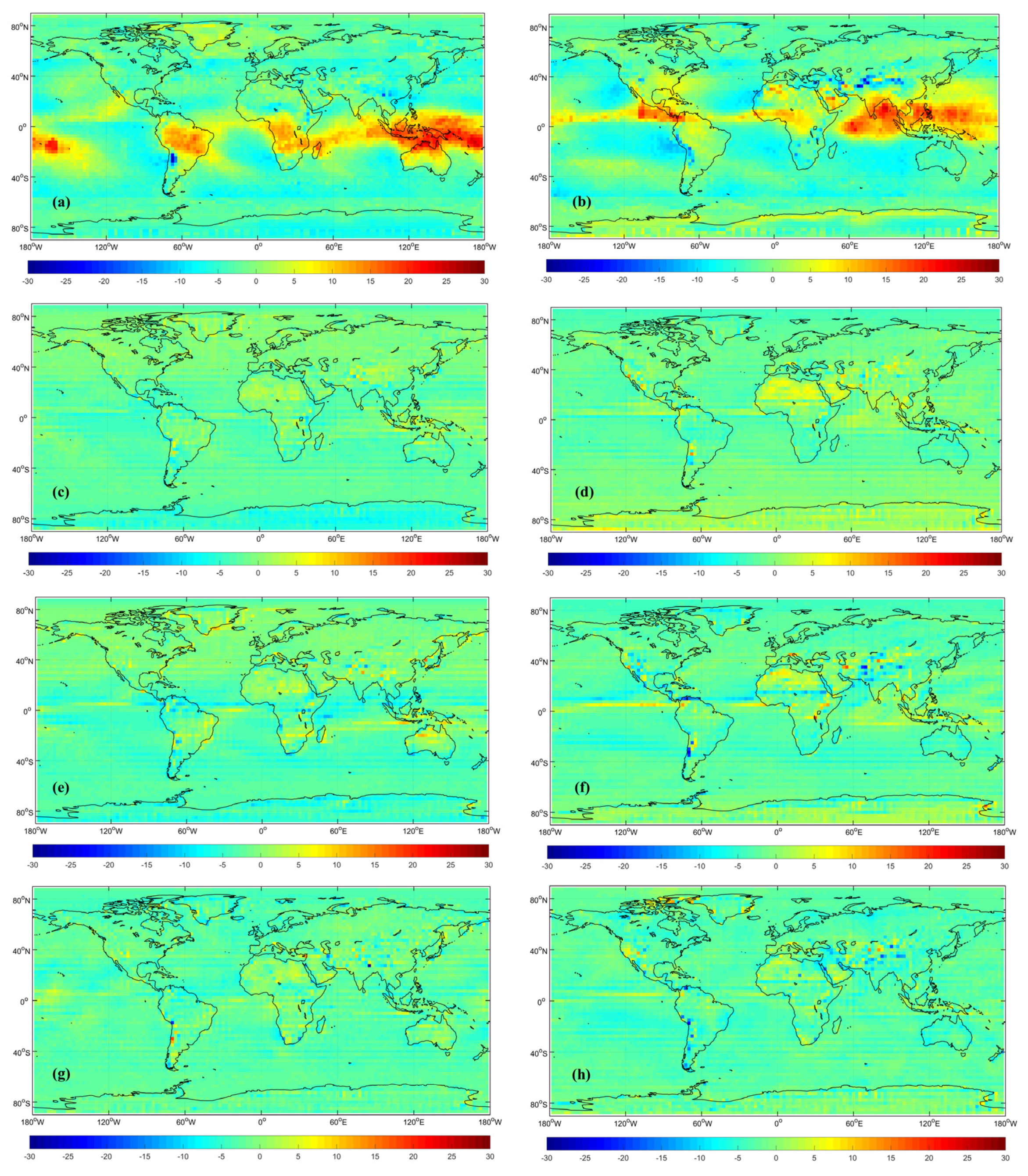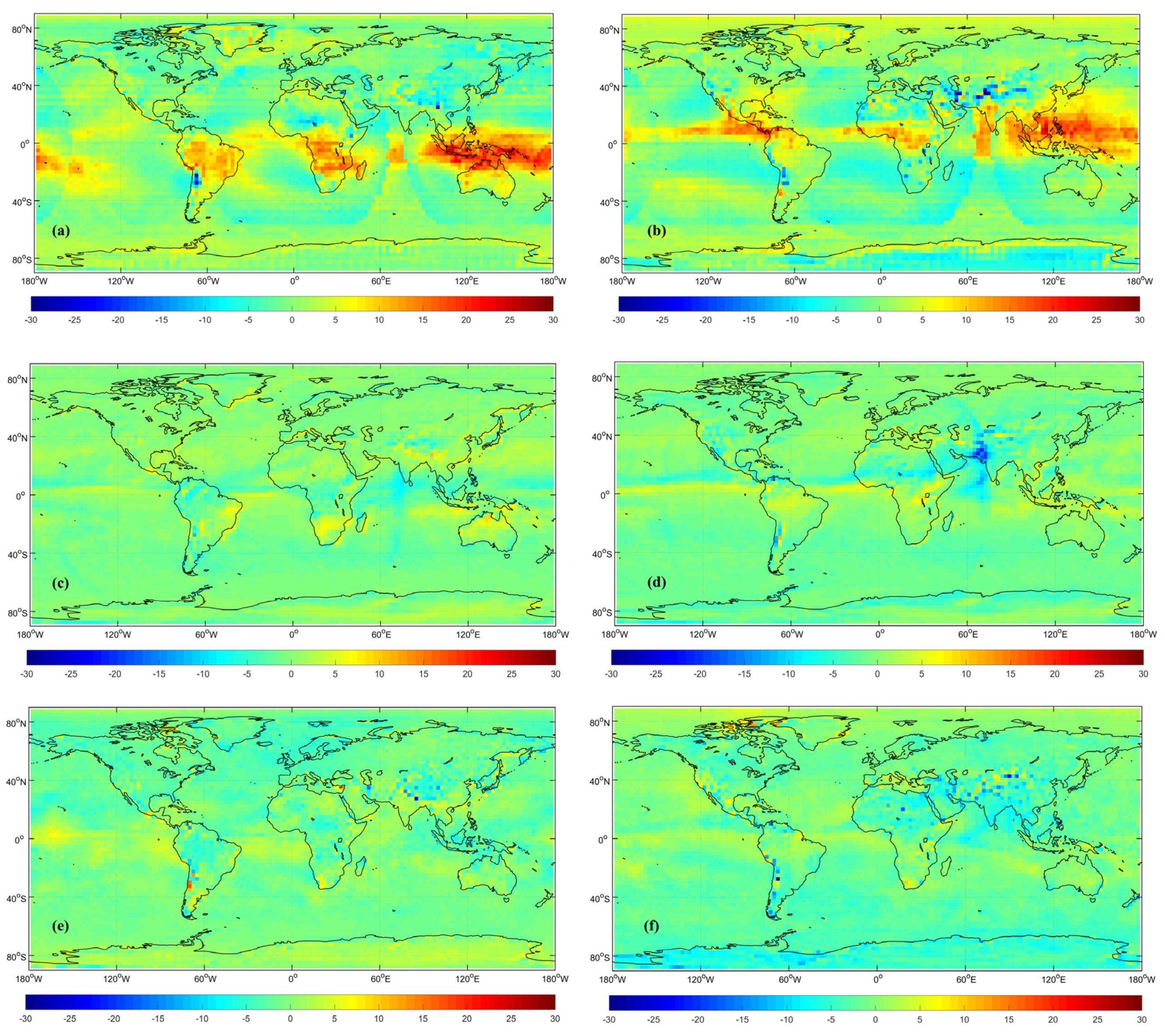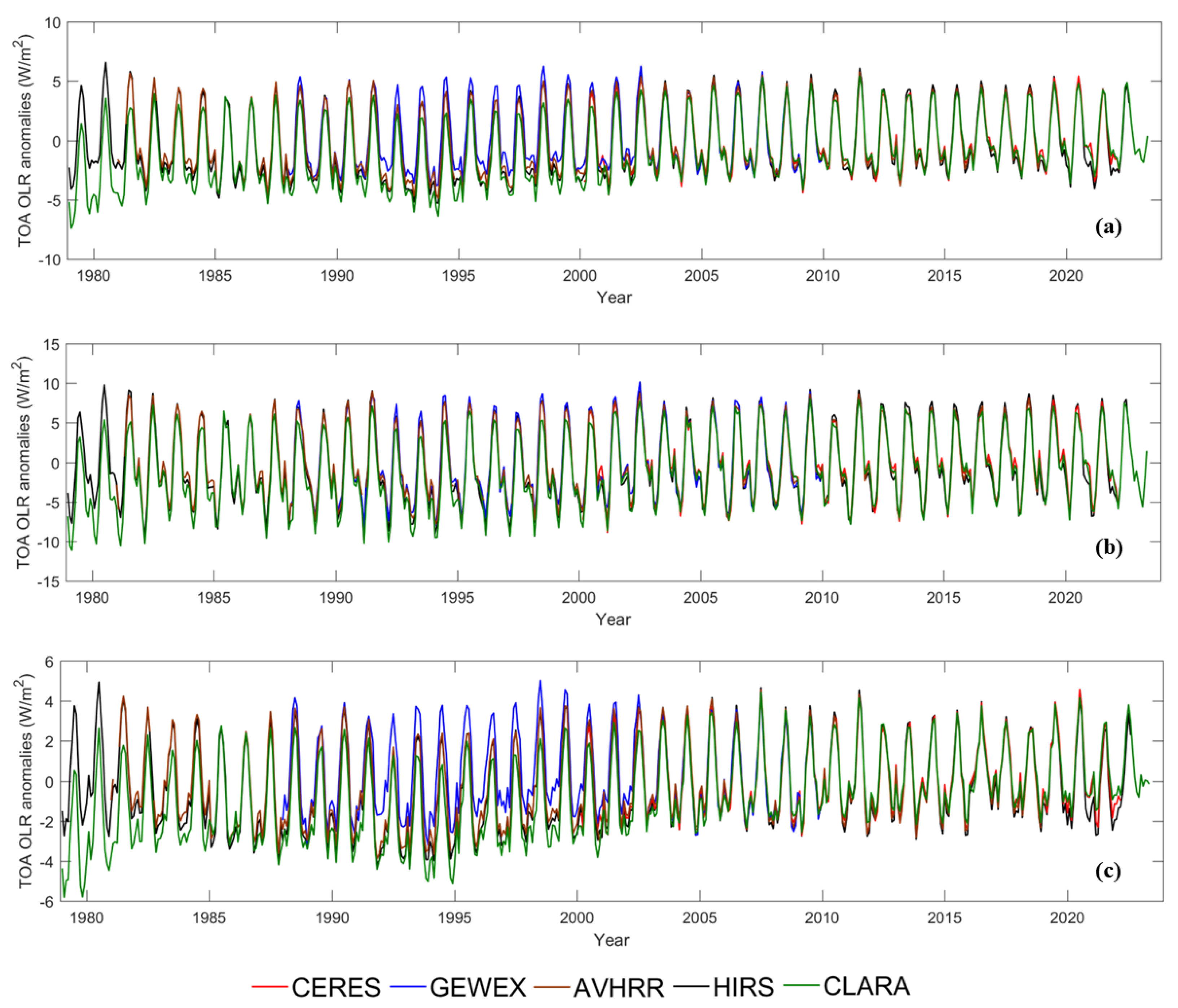Evaluation of Five Global Top-of-Atmosphere Outgoing Longwave Radiation Products
Abstract
:1. Introduction
2. Data and Method
2.1. CERES OLR
2.2. HIRS OLR
2.3. GEWEX OLR
2.4. AVHRR OLR
2.5. CLARA OLR
2.6. Data Processing
3. Results Analysis
4. Conclusions
Author Contributions
Funding
Data Availability Statement
Acknowledgments
Conflicts of Interest
References
- Liang, S.; Wang, D.; He, T.; Yu, Y. Remote sensing of earth’s energy budget: Synthesis and review. Int. J. Digit. Earth 2019, 12, 737–780. [Google Scholar] [CrossRef] [Green Version]
- Schmetz, J.; Liu, Q. Outgoing longwave radiation and its diurnal variation at regional scales derived from Meteosat. J. Geophys. Res. Atmos. 1988, 93, 11192–11204. [Google Scholar] [CrossRef]
- Schmidt, G.; Andrews, T.; Bauer, S.E.; Durack, P.J.; Loeb, N.; Ramaswamy, V.; Arnold, N.P.; Bosilovich, M.G.; Cole, J.; Horowitz, L.W. CERESMIP: A climate modeling protocol to investigate recent trends in the Earth’s Energy Imbalance. Front. Clim. 2023, 5, 1202161. [Google Scholar] [CrossRef]
- Barkstrom, B.R. The earth radiation budget experiment (ERBE). Bull. Am. Meteorol. Soc. 1984, 65, 1170–1185. [Google Scholar] [CrossRef]
- Kandel, R.; Viollier, M.; Raberanto, P.; Duvel, J.P.; Pakhomov, L.; Golovko, V.A.; Trishchenko, A.P.; Mueller, J.; Raschke, E.; Stuhlmann, R.; et al. The ScaRaB earth radiation budget dataset. Bull. Am. Meteorol. Soc. 1998, 79, 765–784. [Google Scholar] [CrossRef]
- Harries, J.E.; Russell, J.; Hanafin, J.; Brindley, H.; Futyan, J.; Rufus, J.; Kellock, S.; Matthews, G.; Wrigley, R.; Last, A.; et al. The geostationary earth radiation budget project. Bull. Am. Meteorol. Soc. 2005, 86, 945–960. [Google Scholar] [CrossRef] [Green Version]
- Loeb, N.G.; Doelling, D.R.; Wang, H.; Su, W.; Nguyen, C.; Corbett, J.G.; Liang, L.; Mitrescu, C.; Rose, F.G.; Kato, S. Clouds and the earth’s radiant energy system (CERES) energy balanced and filled (EBAF) top-of-atmosphere (TOA) edition-4.0 data product. J. Clim. 2018, 31, 895–918. [Google Scholar] [CrossRef]
- Lee, H.-T.; Gruber, A.; Ellingson, R.G.; Laszlo, I. Development of the HIRS outgoing longwave radiation climate dataset. J. Atmos. Ocean. Technol. 2007, 24, 2029–2047. [Google Scholar] [CrossRef] [Green Version]
- Ba, M.B.; Ellingson, R.G.; Gruber, A. Validation of a technique for estimating OLR with the GOES sounder. J. Atmos. Ocean. Technol. 2003, 20, 79–89. [Google Scholar] [CrossRef]
- Lee, T.F.; Hawkins, J.; Kuciauskas, A.; Miller, S. Applications and Training for Next-Generation Imagers. Am. Meteorol. Soc. 2010, 91, 727–740. [Google Scholar] [CrossRef] [Green Version]
- Park, M.-S.; Ho, C.-H.; Cho, H.; Choi, Y.-S. Retrieval of outgoing longwave radiation from COMS narrowband infrared imagery. Adv. Atmos. Sci. 2015, 32, 375–388. [Google Scholar] [CrossRef]
- Rao, Y.; Liang, S.; Wang, D.; Yu, Y.; Song, Z.; Zhou, Y.; Shen, M.; Xu, B. Estimating daily average surface air temperature using satellite land surface temperature and top-of-atmosphere radiation products over the Tibetan Plateau. Remote Sens. Environ. 2019, 234, 111462. [Google Scholar] [CrossRef]
- Schreck, C.; Lee, H.T.; Knapp, K. HIRS Outgoing Longwave Radiation—Daily Climate Data Record: Application toward Identifying Tropical Subseasonal Variability. Remote Sens. 2018, 10, 1325. [Google Scholar] [CrossRef] [Green Version]
- Huang, X.; Yang, W.; Loeb, N.G.; Ramaswamy, V. Spectrally resolved fluxes derived from collocated AIRS and CERES measurements and their application in model evaluation: Clear sky over the tropical oceans. J. Geophys. Res. Atmos. 2008, 113, D09110. [Google Scholar] [CrossRef] [Green Version]
- Whitburn, S.; Clarisse, L.; Bauduin, S.; George, M.; Hurtmans, D.; Safieddine, S.; Coheur, P.F.; Clerbaux, C. Spectrally resolved fluxes from IASI data: Retrieval algorithm for clear-sky measurements. J. Clim. 2020, 33, 6971–6988. [Google Scholar] [CrossRef] [Green Version]
- Peterson, C.A.; Chen, X.; Yue, Q.; Huang, X. The spectral dimension of Arctic outgoing longwave radiation and greenhouse efficiency trends from 2003 to 2016. J. Geophys. Res. Atmos. 2019, 124, 8467–8480. [Google Scholar] [CrossRef]
- Zhan, Y.; Di Girolamo, L.; Davies, R.; Moroney, C. Instantaneous Top-of-Atmosphere Albedo Comparison between CERES and MISR over the Arctic. Remote Sens. 2018, 10, 1882. [Google Scholar] [CrossRef] [Green Version]
- Zhan, C.; Allan, R.P.; Liang, S.; Wang, D.; Song, Z. Evaluation of five satellite top-of-atmosphere albedo products over land. Remote Sens. 2019, 11, 2919. [Google Scholar] [CrossRef] [Green Version]
- Susskind, J.; Molnar, G.; Iredell, L.; Loeb, N.G. Interannual variability of outgoing longwave radiation as observed by AIRS and CERES. J. Geophys. Res. Atmos. 2012, 117, D23107. [Google Scholar] [CrossRef]
- Wang, T.; Zhou, L.; Tan, C.; Divakarla, M.; Pryor, K.; Warner, J.; Wei, Z.; Goldberg, M.; Nalli, N.R. Validation of Near-Real-Time NOAA-20 CrIS Outgoing Longwave Radiation with Multi-Satellite Datasets on Broad Timescales. Remote Sens. 2021, 13, 3912. [Google Scholar] [CrossRef]
- Taylor, P.C.; Itterly, K.F.; Corbett, J.; Bucholtz, A.; Sejas, S.; Su, W.; Doelling, D.; Kato, S. A Comparison of Top-of-Atmosphere Radiative Fluxes from CERES and ARISE. J. Geophys. Res. Atmos. 2022, 127, e2022JD037573. [Google Scholar] [CrossRef]
- Costa, S.; Shine, K. An estimate of the global impact of multiple scattering by clouds on outgoing long-wave radiation. Q. J. R. Meteorol. Soc. J. Atmos. Sci. Appl. Meteorol. Phys. Oceanogr. 2006, 132, 885–895. [Google Scholar] [CrossRef]
- Cox, S.J.; Stackhouse Jr, P.; Gupta, S.; Mikovitz, J.; Zhang, T.; Hinkelman, L.; Wild, M.; Ohmura, A. The NASA/GEWEX surface radiation budget project: Overview and analysis. In Extended Abstracts, Proceedings of the 12th Conference on Atmospheric Radiation, Madison, WI, USA, 10–14 July 2006; American Meteorological Society: Boston, MA, USA, 2006. [Google Scholar]
- Karlsson, K.-G.; Stengel, M.; Meirink, J.F.; Riihelä, A.; Trentmann, J.; Akkermans, T.; Stein, D.; Devasthale, A.; Eliasson, S.; Johansson, E. CLARA-A3: The third edition of the AVHRR-based CM SAF climate data record on clouds, radiation and surface albedo covering the period 1979 to 2023. Earth Syst. Sci. Data Discuss. 2023, 2023, 1–42. [Google Scholar]
- Ellingson, R.G.; Yanuk, D.J.; Lee, H.-T.; Gruber, A. A technique for estimating outgoing longwave radiation from HIRS radiance observations. J. Atmos. Ocean. Technol. 1989, 6, 706–711. [Google Scholar] [CrossRef]
- Stephens, G.; Polcher, J.; Zeng, X.; Van Oevelen, P.; Poveda, G.; Bosilovich, M.; Ahn, M.-H.; Balsamo, G.; Duan, Q.; Hegerl, G. The First 30 years of GEWEX. Bull. Am. Meteorol. Soc. 2022, 104, E126–E157. [Google Scholar] [CrossRef]
- Zhan, C.; Liang, S. Improved estimation of the global top-of-atmosphere albedo from AVHRR data. Remote Sens. Environ. 2022, 269, 112836. [Google Scholar] [CrossRef]
- Xu, J.; Liang, S.; Ma, H.; He, T. Generating 5 km resolution 1981–2018 daily global land surface longwave radiation products from AVHRR shortwave and longwave observations using densely connected convolutional neural networks. Remote Sens. Environ. 2022, 280, 113223. [Google Scholar] [CrossRef]
- Jia, A.; Wang, D.; Liang, S.; Peng, J.; Yu, Y. Global Daily Actual and Snow-Free Blue-Sky Land Surface Albedo Climatology From 20-Year MODIS Products. J. Geophys. Res. Atmos. 2022, 127, e2021JD035987. [Google Scholar] [CrossRef]
- Stackhouse, P.W.; Cox, S.J.; Mikovitz, J.C.; Zhang, T. GEWEX (Global Energy and Water Exchanges Project): Surface Radiation Budget (SRB) Release 4 Integrated Product (IP4)-Algorithm Theoretical Basis Document and Evaluation. 2021. Available online: https://asdc.larc.nasa.gov/documents/srb/SRB_Rel4-IP_ATBD.pdf (accessed on 1 June 2023).





| Data Source | Time Span | Spatial Resolution | Temporal Resolution | Reference |
|---|---|---|---|---|
| CERES | 2000–2021 | 1° | Hourly/daily/monthly | [7] |
| HIRS | 1979–2020 | 2.5° | Daily/monthly | [8] |
| GEWEX | 1988–2009 | 1° | 3-hourly/daily/monthly | [23] |
| AVHRR | 1981–2018 | 0.05° | Daily/monthly | [1] |
| CLARA | 1979–2023 | 0.25° | Daily/monthly | [24] |
| GEWEX | HIRS | AVHRR | CLARA | |||||
|---|---|---|---|---|---|---|---|---|
| RMSE | Bias | RMSE | Bias | RMSE | Bias | RMSE | Bias | |
| January | 5.31 | −1.58 | 2.87 | −2.08 | 3.41 | −2.40 | 3.04 | −2.44 |
| July | 5.04 | −1.29 | 2.43 | −1.16 | 3.31 | −2.19 | 3.28 | −2.57 |
| GEWEX | AVHRR | CLARA | ||||
|---|---|---|---|---|---|---|
| RMSE | Bias | RMSE | Bias | RMSE | Bias | |
| January | 4.49 | 1.06 | 1.75 | −0.24 | 2.35 | −0.95 |
| July | 4.76 | 0.78 | 2.25 | −0.86 | 3.22 | −1.89 |
Disclaimer/Publisher’s Note: The statements, opinions and data contained in all publications are solely those of the individual author(s) and contributor(s) and not of MDPI and/or the editor(s). MDPI and/or the editor(s) disclaim responsibility for any injury to people or property resulting from any ideas, methods, instructions or products referred to in the content. |
© 2023 by the authors. Licensee MDPI, Basel, Switzerland. This article is an open access article distributed under the terms and conditions of the Creative Commons Attribution (CC BY) license (https://creativecommons.org/licenses/by/4.0/).
Share and Cite
Zhan, C.; Yang, J.; Li, Y.; Chen, Y.; Miao, Z.; Zeng, X.; Li, J. Evaluation of Five Global Top-of-Atmosphere Outgoing Longwave Radiation Products. Remote Sens. 2023, 15, 3722. https://doi.org/10.3390/rs15153722
Zhan C, Yang J, Li Y, Chen Y, Miao Z, Zeng X, Li J. Evaluation of Five Global Top-of-Atmosphere Outgoing Longwave Radiation Products. Remote Sensing. 2023; 15(15):3722. https://doi.org/10.3390/rs15153722
Chicago/Turabian StyleZhan, Chuan, Jing Yang, Yan Li, Yong Chen, Zuohua Miao, Xiangyang Zeng, and Jun Li. 2023. "Evaluation of Five Global Top-of-Atmosphere Outgoing Longwave Radiation Products" Remote Sensing 15, no. 15: 3722. https://doi.org/10.3390/rs15153722
APA StyleZhan, C., Yang, J., Li, Y., Chen, Y., Miao, Z., Zeng, X., & Li, J. (2023). Evaluation of Five Global Top-of-Atmosphere Outgoing Longwave Radiation Products. Remote Sensing, 15(15), 3722. https://doi.org/10.3390/rs15153722







